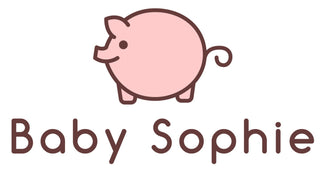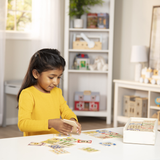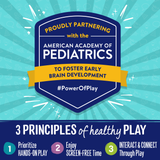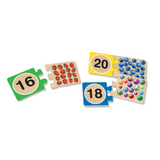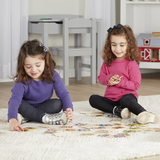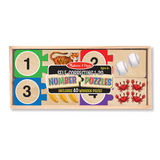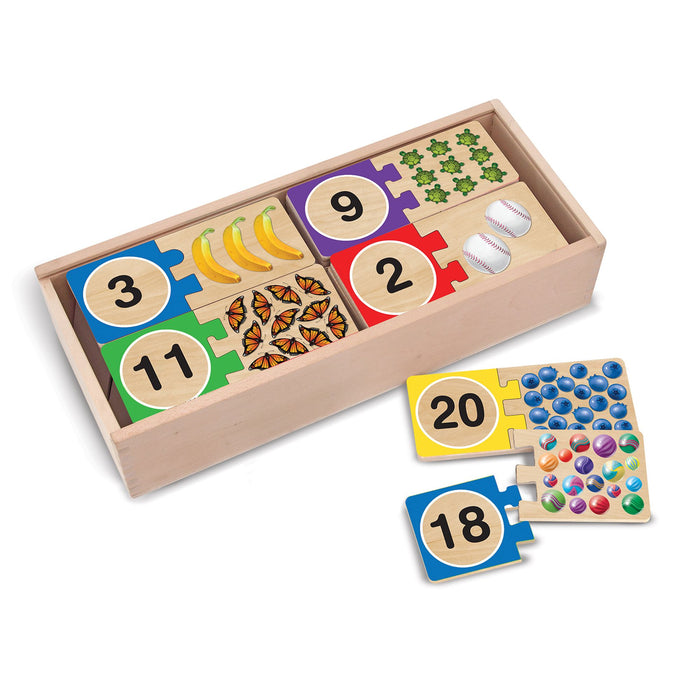MELISSA & DOUG
Melissa & Doug Self-Correcting Number Puzzles
SKU: MND42
Match these wooden puzzle pairs to make mastering numbers as easy as 1, 2, 3. Groups of objects illustrate numbers 1-20 , and the puzzles are self-correcting--each piece has only one match that fits--so children can play independently and learn at the same time.
Features
-
Great for matching and counting skills
-
Color pictures feature familiar objects.
-
Wooden storage box with slide-in lid
-
40 wooden pieces
-
4+ years
Ways To Play
-
MATCHING GAME: Separate several interlocked puzzles into two pieces. Place the number and picture pieces face up into separate piles. Select one number piece and say the number aloud. Ask the child to match the number piece to the correct picture piece, identify the object and count the number of objects shown on the picture piece. Increase the number of puzzles used as the child's counting skills improve.
-
COUNTING ACTIVITIES: Line up interlocked puzzles 1 through 3. Beginning with 1, point to and say the number, then point to the picture and count the objects aloud (1). Encourage the child to count with you. Continue numerically, adding puzzles to increase the challenge. When the child is ready, point to puzzles in random order. Separate several interlocked puzzles into two pieces and ask the child to count the pieces. Add more pieces when the child is ready.
-
NUMBER RECOGNITION: Line up several number pieces in numerical order, beginning with 1. Encourage the child to count aloud with you as you point to each number. Ask the child to trace each number using a finger. Point to numbers randomly and encourage the child to say each number aloud. Add more number pieces when the child is ready. When the child can identify numbers 1-20, ask him/her to point to numbers in response to questions. For example, you might ask, "How old are you?" The child should point to the number matching his/her age.
-
ADD AND SUBTRACT: Lay two or three pieces face down and ask the child to count them. Use the pieces to guide the child through addition problems. For example, you might say, "If we have two pieces and add one more piece, how many pieces are there? Two plus one is three!" Encourage subtraction skills by removing pieces.
-
COLOR RECOGNITION: Line up several interlocked puzzles. Point to and name different colors found on the puzzles. Encourage the child to name the colors aloud with you.
-
MEMORY GAME: Place several number or picture pieces face up in front of the child. Ask the child to memorize the pieces and close his/her eyes. Remove one piece and explain that one is missing. The child should open his/her eyes and describe the missing piece. Increase the number of pieces used as the child's memory skills grow.
-
GUESSTIMATING: Ask the child to close his/her eyes, while an adult makes two piles of pieces. One pile should contain 1 or 2 pieces, and the other pile should contain 5 or 6 pieces. Ask the child to open his/her eyes and, without counting, identify the pile containing MORE pieces. Count the pieces in each pile with the child to confirm the answer. Continue this activity using new piles, sometimes making the piles UNEQUAL, and sometimes making the piles EQUAL.
-
GRAB BAG GAME: (for 2 to 4 players) Distribute an equal number of interlocked puzzles to each player: 2 players get 10 puzzles each, 3 players get 6 each, and 4 players get 5 each. Remove extra puzzles from play. All players separate their puzzles into two pieces and put their picture pieces into one large paper bag or pillowcase. The youngest player goes first, reaching into the bag without peeking. Players use their hands to examine the shape of the picture pieces, trying to find a piece to interlock with one of their number pieces. If the chosen picture piece matches one of that player"s number pieces, the player must name the number or count the objects on the picture piece aloud before interlocking the pieces. If the selected picture piece does not match, it goes back into the bag. Play moves to the right until one player's puzzles are all completed.
-
PICK THE PICTURE: Place several picture pieces face up in front of the child. Without touching any pieces, secretly choose one. Give clues to help the child identify the picture you chose. For example, you might say, "These objects grow on trees. Squirrels like to bury them. They are brown." Remove picture pieces from play as they are eliminated by clues. The solution to these clues is the acorn picture piece. Encourage the child to count the images on the picture piece and match it with the correct number piece.
-
STORY TIME: Lay all of the picture pieces face up and inspire the child's creativity by using the pictures as details in a story you make up together. For example, you might say, "Today is Charlie Crab's birthday! Which friends are coming to his party? What will Charlie and his friends eat at the party?" Encourage the child to use his/her imagination and have fun!
